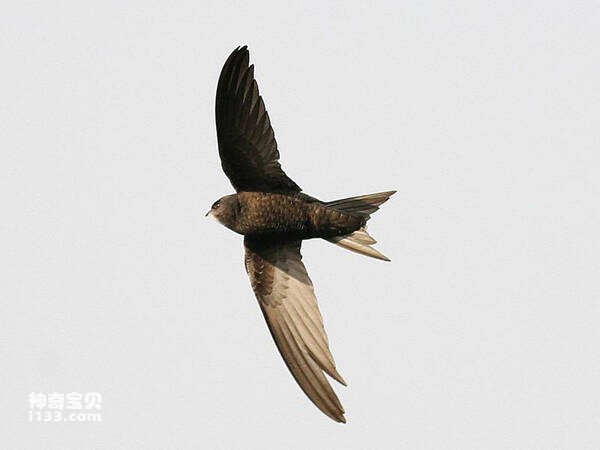Apus apus
IUCN
LCBasic Information
Scientific classification
- name:Apus apus
- Scientific Name:Apus apus,Common Swift,European Swift,Swift,Martinet noir
- Outline:Climbing birds
- Family:
Vital signs
- length:16-18CM
- Weight:29-41g
- lifetime:No textual research information is available
Feature
The white throat and chest are separated by a dark brown band
Distribution and Habitat
Breeding ground: Afghanistan, Albania, Andorra, Armenia, Austria, Azerbaijan, Belarus, Belgium, Bosnia and Herzegovina, Bulgaria, China, Croatia, Cyprus, Czech Republic, Estonia, Georgia, Gibraltar, Hungary, India, Ireland, Israel, Kazakhstan, Kyrgyzstan, Latvia, Liechtenstein, Lithuania, Rwanda Samburg, Malta, Moldova, Mongolia, Montenegro, Nepal, Netherlands, North Macedonia, Norway, Pakistan, Poland, Portugal, Romania, Russia, Serbia, Slovakia, Slovenia, Spain, Sweden, Switzerland, Tajikistan, Turkey, Turkmenistan, United Kingdom and Uzbekistan.
Travellers: Bahrain, Jordan, Kuwait, Oman, Palestine, Qatar, Saudi Arabia, South Sudan, UAE and Yemen.
Resident Bird: Algeria, Angola, Benin, Botswana, Burkina Faso, Burundi, Cameroon, Central African Republic, Chad, Democratic Republic of the Congo, Burkina Faso, Honduras, Denmark, Djibouti, Egypt, Equatorial Guinea, Eritrea, Swatini, Ethiopia, Faroe Islands, Finland, France, Gabon, Gambia, Germany, Ghana, Greece, Guinea Africa, Guine
Appearance
The head and upper body of the common swallow are dark brown, and the head and back feathers are darker and slightly glossy. The two wings are long and narrow, sickle-shaped, and the outer and tail surfaces of the primary flight feathers of the two wings have a slight copper green luster. The tail is forked. Chin and throat are grayish white, with light brown fine plumage. The thorax, ventral and undertail coverts are dark brown, with a narrow gray-white margin on the abdomen. The iris is dark brown, the mouth is short and wide and flat, pure black, and the feet are dark brown.
The young bird's forehead is grayish white, the whole body is smoke-brown, dull, and has a narrow grayish white feather margin. Chin and larynx are grayish and extend to upper thorax.
Size measurement: weight 29-40g, ♀ 31-41g; The body length is 168-184 mm, ♀169-176 mm; Rostral peak 6-7 mm, ♀6-8 mm; Wings are 154-177 mm, ♀155-175 mm; Tail ♂ 73-87mm, ♀ 76-90mm; The tarsometatarsus is 8-11 mm, ♀10-12 mm
Details
The Common swallow (Apus apus) has two subspecies: common Swift, European Swift, Swift, and Martinet noir. The common louver was one of the many species described by the Swedish naturalist Carl Linnaeus in 1758 in the tenth edition of his Systema Naturae. He introduced the binomial name "Hirundo apus". The current genus "Apus" was established in 1777 by the Italian naturalist Giovanni Antonio Scopoli, based on synonyms. The word "apus" is Latin for "swift." It derives from the Ancient Greek words α, a, "without", and πούς, pous, "foot", based on the idea that these birds were a kind of swallow without feet. The Central European subspecies that lived during the last Ice Age is described as "Apus apus palapus".

Common swallow is a seasonal summer migratory bird. The wintering areas are in tropical Africa and northern India. Spring moves in from April to May and autumn moves out from September to October. The flapping frequency is relatively slow. During the day, groups often fly in the sky to hunt. Especially in the morning and evening, cloudy days and rain before the most active. It can fly very fast, reaching speeds of 110 kilometers per hour. Often called while flying, the cry is crisp and loud. It feeds mainly on insects, especially flying insects. They often hunt while flying.

The breeding period of common swallows is from June to July. They often nest together and breed. Usually nests in tall ancient buildings, pagodas, temples, palaces, ceilings, beams and wall caves, but also in rock walls, wall caves. The height from the ground is mostly about 10-30 meters. The nest is made from a mixture of dead stems, leaves, hemp, rags, fibers, paper scraps and soil. It is covered with soft material such as feather, feather and hair. The shape of the nest is saucer-like. The size is 10-13 cm outside diameter, 8-9 cm inside diameter, and 3-6 cm high nest. Can be used for many years. Each brood lays 2-4 eggs, mostly 3 eggs, white without spots, the size of 24-26×15-17 mm, oval shape, male and female incubate eggs in turn, incubation period of 21-23 days. The chicks are late sex and can fly after about 30 days of feeding by the parent birds.

In 2015, the total number of common swallow pairs in Europe was estimated at 19,100,000-32,500,000, equivalent to 38,200,000-65 million mature individuals. Europe accounts for 40% of the global range on average, so the initial estimate of the global species population size is 955,000-162,500,000 mature individuals, although further verification of this estimate is required. Thus, the total population of the species is placed between 95,000,000 and 164,999,999 mature individuals. The trend in species numbers in Europe between 1980 and 2013 is estimated to be stable (EBCC 2015). In China, the general population is rare and common only in local areas, which requires strict protection.
Listed on the IUCN Red List of Threatened Species (IUCN)2016 ver3.1 - Not Threatened (LC).
It was included in the List of Beneficial Terrestrial Wildlife under State Protection or of Important economic and scientific research Value issued by the State Forestry Administration of China on August 1, 2000.
Protect wild animals and eliminate wild meat.
Maintaining ecological balance is everyone's responsibility!








